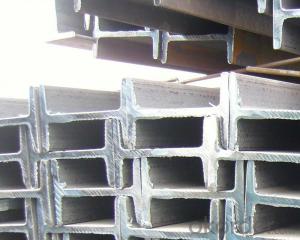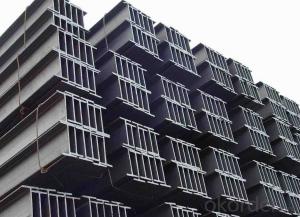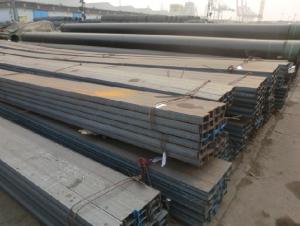High quality I beam GB Q235 or equivalent 80mm-270mm
- Loading Port:
- Tianjin
- Payment Terms:
- TT OR LC
- Min Order Qty:
- 25 m.t.
- Supply Capability:
- 20000 m.t./month
OKorder Service Pledge
OKorder Financial Service
You Might Also Like
IPE Details:
| Minimum Order Quantity: | Unit: | m.t. | Loading Port: | ||
| Supply Ability: | Payment Terms: | Package: | wire rod bundle |
Product Description:
Product Description:
Specifications of IPE Beam
1. Invoicing on theoretical weight or actual weight as customer request
2. Standard: EN10025, GB Standard, ASTM
3. Grade: Q235B, Q345B, SS400, ASTM A36, S235JR, S275JR
4. Length: 5.8M, 6M, 9M, 12M as following table
5. Sizes: 80mm-270mm
Dimensions(mm) | |||||
h | b | s | t | Mass Kg/m | |
IPE80 | 80 | 46 | 3.80 | 5.20 | 6.00 |
IPE100 | 100 | 55 | 4.10 | 5.70 | 8.10 |
IPE120 | 120 | 64 | 4.80 | 6.30 | 10.40 |
IPE140 | 140 | 73 | 4.70 | 6.90 | 12.90 |
IPE160 | 160 | 82 | 5.00 | 7.40 | 15.80 |
IPE180 | 180 | 91 | 5.30 | 8.00 | 18.80 |
IPE200 | 200 | 100 | 5.60 | 8.50 | 22.40 |
IPE220 | 220 | 110 | 5.90 | 9.20 | 26.20 |
IPE240 | 240 | 120 | 6.20 | 9.80 | 30.70 |
IPE270 | 270 | 135 | 6.60 | 10.20 | 36.10 |
Appications of IPE Beam
1. Supporting members, most commonly in the house raising industry to strengthen timber bears under houses. Transmission line towers, etc
2. Prefabricated structure
3. Medium scale bridges
4. It is widely used in various building structures and engineering structures such as roof beams, bridges, transmission towers, hoisting machinery and transport machinery, ships, industrial furnaces, reaction tower, container frame and warehouse etc.
Package & Delivery of IPE Beam
1. Packing: it is nude packed in bundles by steel wire rod
2. Bundle weight: not more than 3.5MT for bulk vessel; less than 3 MT for container load
3. Marks: Color marking: There will be color marking on both end of the bundle for the cargo delivered by bulk vessel. That makes it easily to distinguish at the destination port.
4. Tag mark: there will be tag mark tied up on the bundles. The information usually including supplier logo and name, product name, made in China, shipping marks and other information request by the customer.
If loading by container the marking is not needed, but we will prepare it as customer request.
5. Transportation: the goods are delivered by truck from mill to loading port, the maximum quantity can be loaded is around 40MTs by each truck. If the order quantity cannot reach the full truck loaded, the transportation cost per ton will be little higher than full load.
6. Delivery of IPE Beam: 30 days after getting L/C Original at sight or T/T in advance
Production flow of IPE Beam
Material prepare (billet) —heat up—rough rolling—precision rolling—cooling—packing—storage and transportation
- Q:How do steel I-beams perform in areas with high levels of seismic activity?
- Steel I-beams are well-suited for areas with high levels of seismic activity due to their superior strength and flexibility. These beams have excellent resistance to lateral forces and can withstand the shaking and vibrations caused by earthquakes. Their robust construction and ability to dissipate energy make them a reliable choice for structural support, ensuring the safety and stability of buildings in seismic-prone regions.
- Q:Can steel I-beams be used in educational or institutional buildings?
- Yes, steel I-beams can definitely be used in educational or institutional buildings. Steel I-beams are commonly used in construction due to their strength, durability, and versatility. They provide structural support and can bear heavy loads, making them ideal for large-scale buildings. Additionally, steel I-beams are resistant to fire, pests, and rot, ensuring the safety and longevity of the building. Their flexibility also allows for open floor plans and large spans, which are often desired in educational or institutional settings. Overall, steel I-beams are a popular choice in construction and can certainly be used in educational or institutional buildings.
- Q:What are the factors that affect the strength of steel I-beams?
- There are several factors that can affect the strength of steel I-beams. 1. Material quality: The quality of the steel used in manufacturing the I-beams plays a crucial role in determining their strength. Steel with higher yield and tensile strengths will generally result in stronger I-beams. 2. Cross-sectional shape: The shape of the I-beam's cross-section can impact its strength. The depth and thickness of the flanges and the web, as well as the overall geometry, contribute to the beam's ability to resist bending and torsional forces. 3. Load distribution: The way in which the load is distributed across the beam can affect its strength. Uneven loading or concentrated loads in specific areas can lead to localized stress and potential failure. 4. Span length: The length of the span or the distance between supports can influence the strength of the I-beams. Longer spans can induce higher bending moments, requiring stronger beams to withstand the applied loads. 5. Temperature: Steel undergoes thermal expansion and contraction with temperature changes. Extreme temperature variations can affect the strength of steel I-beams, causing them to expand or contract, potentially leading to structural integrity issues. 6. Weld quality: Welds used to join different sections of I-beams can impact their overall strength. High-quality welds that are properly executed can contribute to the structural integrity of the beams. 7. Corrosion and environmental factors: Exposure to corrosive substances or harsh environmental conditions such as moisture, chemicals, and saltwater can deteriorate the steel's strength over time. Regular maintenance and protective coatings can help mitigate these effects. It is important to consider these factors when designing and selecting steel I-beams for various applications to ensure the desired strength and structural integrity.
- Q:How are steel I-beams used in multi-story buildings?
- Steel I-beams are commonly utilized in multi-story buildings as essential structural components that offer support and stability. These beams are typically constructed from steel due to its exceptional strength and durability. I-beams are specifically designed to bear heavy loads and evenly distribute the weight across the entire structure. They are frequently employed as horizontal beams, known as floor joists, to uphold the weight of the floors as well as any additional loads such as furniture, equipment, and people. Apart from their role in supporting the floors, steel I-beams are also utilized as vertical columns or beams to provide vertical support for the entire building. These columns aid in transferring the weight of the upper floors downwards to the foundation, thereby guaranteeing the stability and integrity of the structure. The utilization of steel I-beams in multi-story buildings offers numerous advantages due to their impressive strength-to-weight ratio. This means they can effectively support heavy loads without being excessively bulky or cumbersome. Consequently, this allows for a more efficient utilization of space and enables architects and engineers to design taller and more spacious buildings. In addition, steel I-beams possess fire-resistant properties, which is of utmost importance for the safety of occupants in the event of a fire. They exhibit superior resistance to high temperatures for an extended period when compared to other building materials, thereby minimizing the risk of structural collapse. In summary, steel I-beams fulfill a critical role in multi-story buildings by providing structural support, distributing loads, ensuring stability, and enhancing the safety and longevity of the structure.
- Q:How are steel I-beams connected to other structural elements?
- Steel I-beams are typically connected to other structural elements through welding, bolting, or through the use of specialized connectors such as beam clamps or cleats. These connections ensure the stability and integrity of the overall structure by transferring loads and forces between the I-beams and other components.
- Q:How do steel I-beams perform in terms of load redistribution?
- Steel I-beams are incredibly efficient when it comes to redistributing loads. The distinctive shape of the I-beam, complete with flanges and a web, enables it to evenly distribute the applied load throughout its entire length. The flanges, positioned at the top and bottom of the beam, have been engineered to resist bending and compression forces, while the web, located between the flanges, is designed to withstand shear forces. When a load is placed on an I-beam, the flanges and web collaborate to spread the load across the entire length of the beam. The flanges bear the majority of the load, while the web helps combat shear forces. By redistributing the load in this manner, the beam is able to endure heavy loads without excessive deflection or failure. Moreover, steel I-beams possess a remarkable strength-to-weight ratio, making them the perfect choice for supporting hefty loads over long distances. This allows for the construction of structures with fewer support columns or walls, creating more open and adaptable spaces. To sum up, steel I-beams are exceptional at redistributing loads due to their unique shape and design. They have the ability to efficiently distribute loads along their length, minimizing deflection and maintaining structural integrity even under significant loads.
- Q:Can steel I-beams be used in coastal or marine environments?
- Yes, steel I-beams can be used in coastal or marine environments with proper precautions and maintenance. Stainless steel, galvanized steel, or other corrosion-resistant coatings can be applied to protect the steel from the corrosive effects of saltwater and moisture. Regular inspections and maintenance are also necessary to prevent any potential corrosion or damage. Additionally, proper design considerations should be taken into account, such as the use of sacrificial anodes to further protect the steel from corrosion. By implementing these measures, steel I-beams can withstand the challenging conditions of coastal or marine environments.
- Q:What are the different load types that steel I-beams can withstand?
- Steel I-beams possess great strength and load-bearing capacity, making them highly favored in the fields of construction and engineering. These beams are specifically constructed to endure different forms of loads, including: 1. Dead Load: This pertains to the weight of the building or structure's permanent fixtures and materials, as well as the structural elements themselves. Steel I-beams are engineered to effectively support dead loads, such as the weight of floors, walls, roofs, and other permanent components. 2. Live Load: Also referred to as imposed load, this represents the dynamic or moving loads that a structure may encounter during its intended usage. The magnitude of these loads may vary depending on the purpose of the building. For instance, an office building may experience live loads from people, furniture, equipment, and other movable objects. 3. Wind Load: Steel I-beams are designed to withstand the forces exerted by wind. When wind blows against a building, it generates both positive and negative pressures on the structure. These I-beams are engineered to resist these lateral forces and transmit them down to the foundation, thereby ensuring the stability of the building. 4. Snow Load: In regions with heavy snowfall, steel I-beams must possess the ability to support the weight of accumulated snow on the roof. Snow loads may vary based on factors such as snow density, wind direction, and roof slope. The I-beams are designed to evenly distribute this load, thus preventing structural failure. 5. Seismic Load: Areas prone to earthquakes necessitate steel I-beams that can withstand the lateral forces and ground motion generated by such events. These beams are designed with specific seismic design criteria to guarantee the safety and stability of the structure during an earthquake. 6. Impact Load: Certain structures may encounter impact loads caused by moving vehicles, machinery, or falling objects. Steel I-beams can be tailored to endure these sudden and concentrated loads, thereby ensuring the integrity of the structure even in such circumstances. In general, steel I-beams possess versatility and the ability to withstand a wide range of load types. Their strength, durability, and capacity to distribute and transfer loads make them a reliable choice for various construction and engineering applications.
- Q:Are there any special considerations when designing with steel I-beams in residential applications?
- Yes, there are several special considerations when designing with steel I-beams in residential applications. Firstly, it is important to consider the load-bearing capacity of the I-beams. Unlike wood or other materials, steel I-beams have high strength-to-weight ratio, allowing them to support heavy loads. However, it is crucial to accurately calculate the loads and forces that will be applied to the beams in order to ensure they are adequately sized and spaced to provide sufficient support. Another consideration is the proper installation and support of the I-beams. Steel I-beams require proper bracing and connections to ensure they are securely fastened and can effectively transfer loads to the foundation or supporting structure. It is important to consult with a structural engineer or other qualified professional to determine the appropriate installation methods and ensure compliance with local building codes. Additionally, steel I-beams can be susceptible to corrosion if not properly protected. In residential applications, where the beams may be exposed to moisture or other corrosive elements, it is important to use appropriate protective coatings or treatments to prevent rust and deterioration. Regular inspections and maintenance should also be performed to identify and address any signs of corrosion. Fire protection is another consideration when designing with steel I-beams. While steel is inherently fire-resistant, prolonged exposure to high temperatures can weaken the beams. Therefore, it may be necessary to incorporate fire-resistant materials, such as spray-on fireproofing or fire-rated drywall, to enhance the fire resistance of the overall system. Lastly, it is important to consider the aesthetic aspect of steel I-beams in residential applications. While some homeowners may appreciate the industrial or modern look of exposed steel beams, others may prefer a more traditional or concealed appearance. Designers and architects should take into account the homeowner's preferences and explore creative solutions to integrate the steel I-beams into the overall design scheme. In summary, when designing with steel I-beams in residential applications, special considerations include load-bearing capacity, proper installation and support, corrosion protection, fire protection, and aesthetic integration. Consulting with professionals and adhering to local building codes will ensure that the design is safe, durable, and meets the specific needs and preferences of the homeowner.
- Q:What are the factors that affect the weight of steel I-beams?
- Several factors influence the weight of steel I-beams. Firstly, the weight is determined by the size and dimensions of the I-beam. The length, height, and width directly impact the weight, with longer and larger beams being heavier. Secondly, the weight is affected by the type and grade of steel used in manufacturing the I-beam. Different types, like carbon steel or alloy steel, have varying densities and weight per unit volume. Higher-grade steels, while stronger and more durable, may also be denser, resulting in a heavier beam. The thickness of the web and flanges is another factor that influences the weight of steel I-beams. Increasing the thickness of these sections can increase the beam's weight. Additionally, the weight can be impacted by the presence of additional features such as holes, notches, or attachments. Depending on their size and location, these features can either increase or decrease the overall weight. Lastly, the weight of the I-beam can be influenced by the manufacturing process used. Different fabrication methods, like hot-rolling or cold-forming, can result in variations in weight due to differences in material density and structural integrity. To summarize, the weight of steel I-beams is influenced by factors such as size, dimensions, type of steel, thickness of the web and flanges, presence of additional features, and the manufacturing process.
1. Manufacturer Overview |
|
|---|---|
| Location | |
| Year Established | |
| Annual Output Value | |
| Main Markets | |
| Company Certifications | |
2. Manufacturer Certificates |
|
|---|---|
| a) Certification Name | |
| Range | |
| Reference | |
| Validity Period | |
3. Manufacturer Capability |
|
|---|---|
| a)Trade Capacity | |
| Nearest Port | |
| Export Percentage | |
| No.of Employees in Trade Department | |
| Language Spoken: | |
| b)Factory Information | |
| Factory Size: | |
| No. of Production Lines | |
| Contract Manufacturing | |
| Product Price Range | |
Send your message to us
High quality I beam GB Q235 or equivalent 80mm-270mm
- Loading Port:
- Tianjin
- Payment Terms:
- TT OR LC
- Min Order Qty:
- 25 m.t.
- Supply Capability:
- 20000 m.t./month
OKorder Service Pledge
OKorder Financial Service
Similar products
New products
Hot products
Hot Searches
Related keywords

































